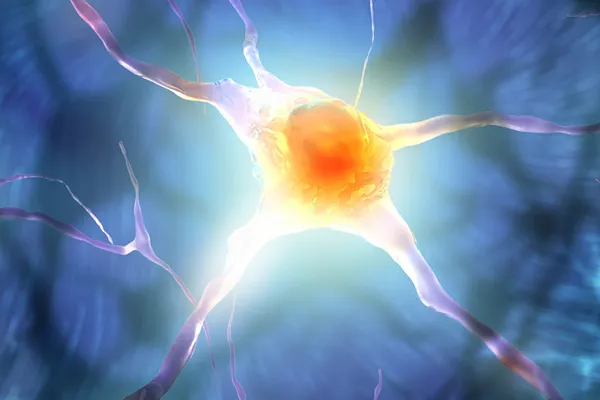Articles & Research

How the brain rewards pleasurable physical touch
The COVID-19 pandemic left many alone in their homes. A lack of physical touch – kissing, holding hands, snuggling – can leave people feeling isolated and without a source of joy in their lives. It can even lead to anxiety, depression, chronic stress, and can exacerbate autism symptoms (1). However, the way mechanical force transmitted through the skin, like in the form of a hug, gets translated into neuronal action in a mammalian brain has never been understood.
A group of scientists led by Ishmail Abdus-Saboor at Columbia University have now identified the neurons in the skin that respond to gentle touches by setting off a neurochemical cascade that ends in the reward center of the brain. Published in the journal Cell, the work centers around a lineage of neurons dubbed Mrgprb4, which are sensory cells named after a membrane receptor (2).
Neurons in the ventral tegmental area (blue), a reward center in the brain, are stimulated by neurons in the spinal cord (red) that get input from neurons in the skin. CREDIT: ABDUS-SABOOR LAB, ZUCKERMAN INSTITUTE
The team knew that these cells could be activated by touch, but no one knew what role they played in an animal’s behavior (3). “[Previous work] had basically shown these cells are activated by paintbrush stroking, but no one had really followed up on these for years,” said neurobiologist and coauthor Leah Elias. “There was no role for these neurons in any natural behaviors at the time.”
To find out what function Mrgprb4 neurons play in animal behavior, Elias and Abdus-Saboor engineered Mrgprb4 cells to activate in response to light. Mrgprb4 cells live in hairy skin, so they performed the experiment by shining light on mice’s backs where the most hair is.
Mrgprb4 neurons (green) in a mouse’s hairy skin are responsible for transmitting rewarding touch signals to the brain. CREDIT: ABDUS-SABOOR LAB/ZUCKERMAN INSTITUTE
The result was dramatic. When they activated the neurons with repeated bursts of blue light, the mice immediately assumed a sexually receptive position. Control mice that didn’t have the engineered neurons didn’t react at all to the light. The mice with engineered neurons also repeatedly returned to the light chamber, apparently in search of further stimulation. Further experiments showed that stimulating Mrgprb4 neurons led to the release of dopamine in the nucleus accumbens and ventral tegmental area, reward centers in the brain.
“What we missed in the field was proof that touch can actually have this effect on social behavior that we’re talking about", said Amaury François, a neurobiologist at the French National Centre for Scientific Research who was not involved in the work. “Dopamine doesn't necessarily mean pleasure; it means reward. But escaping from something that is dangerous is also rewarding; it doesn't mean that it's actually pleasurable.”
With the help of collaborators at Rutgers University using a technique called fiber photometry, the researchers next traced the path from Mrgprb4 neurons in the skin all the way to the brain, neuron by neuron. According to Elias, this confirmed that simple activation of a peripheral set of neurons was all it took to put a reward circuit in motion. According to the authors, identifying both this circuit and the requirements to activate it could point towards potential therapies, like enhancing or repairing neurological social reward systems that aren’t functioning properly. Work like this could apply in conditions as far afield as autism spectrum disorders, sexual dysfunction, or cases of social isolation, like workers on a graveyard shift.
While Mrgprb4 neurons don’t exist in humans, homologous neurons and circuitry do, among them a class of neurons called C-tactile afferents (4). Other neurons with membrane proteins in Mrgprb4’s family also activate in pain and itch circuitry as well.
“I always give the example of the weighted blanket,” said Elias. “You have just a peripheral activation. You don't need a social context, but you're mimicking some of the therapeutic benefits of a hug. Weighted blankets can reduce anxiety. They mimic the sensation of pressure.”
References
Lee Masson, H., Op de Beeck, H. & Boets, B. Reduced task-dependent modulation of functional network architecture for positive versus negative affective touch processing in autism spectrum disorders. NeuroImage 219, 117009 (2020).
Elias, L. J. et al. Touch neurons underlying dopaminergic pleasurable touch and sexual receptivity. Cell S009286742201577X (2023). doi:10.1016/j.cell.2022.12.034
Vrontou, S., Wong, A. M., Rau, K. K., Koerber, H. R. & Anderson, D. J. Genetic identification of C fibres that detect massage-like stroking of hairy skin in vivo. Nature 493, 669–673 (2013).
Pawling, R., Cannon, P. R., McGlone, F. P. & Walker, S. C. C-tactile afferent stimulating touch carries a positive affective value. PLoS ONE 12, e0173457 (2017).

